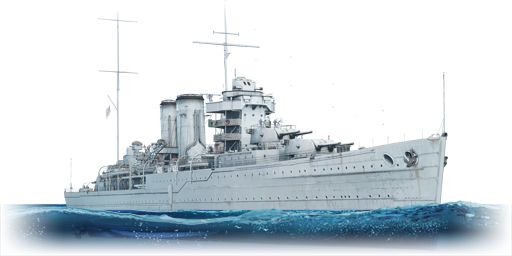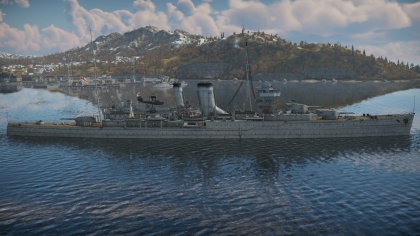HMS York
Contents
Description
The York-class, HMS York (90), 1941 is a rank IV British heavy cruiser
with a battle rating of 5.7 (AB/RB/SB). It was introduced in Update "Starfighters".
General info
Survivability and armour
Talk about the vehicle's armour. Note the most well-defended and most vulnerable zones, e.g. the ammo magazine. Evaluate the composition of components and assemblies responsible for movement and manoeuvrability. Evaluate the survivability of the primary and secondary armaments separately. Don't forget to mention the size of the crew, which plays an important role in fleet mechanics. Save tips on preserving survivability for the "Usage in battles" section. If necessary, use a graphical template to show the most well-protected or most vulnerable points in the armour.
Mobility
Write about the ship's mobility. Evaluate its power and manoeuvrability, rudder rerouting speed, stopping speed at full tilt, with its maximum forward and reverse speed.
| Mobility Characteristics | |||
|---|---|---|---|
| Game Mode | Upgrade Status | Maximum Speed (km/h) | |
| Forward | Reverse | ||
| AB | |||
| Upgraded | 70 | 25 | |
| RB/SB | |||
| Upgraded | 60 | 22 | |
Armament
Primary armament
Provide information about the characteristics of the primary armament. Evaluate their efficacy in battle based on their reload speed, ballistics and the capacity of their shells. Add a link to the main article about the weapon: {{main|Weapon name (calibre)}}. Broadly describe the ammunition available for the primary armament, and provide recommendations on how to use it and which ammunition to choose.
Secondary armament
Some ships are fitted with weapons of various calibres. Secondary armaments are defined as weapons chosen with the control Select secondary weapon. Evaluate the secondary armaments and give advice on how to use them. Describe the ammunition available for the secondary armament. Provide recommendations on how to use them and which ammunition to choose. Remember that any anti-air armament, even heavy calibre weapons, belong in the next section. If there is no secondary armament, remove this section.
Anti-aircraft armament
An important part of the ship's armament responsible for air defence. Anti-aircraft armament is defined by the weapon chosen with the control Select anti-aircraft weapons. Talk about the ship's anti-air cannons and machine guns, the number of guns and their positions, their effective range, and about their overall effectiveness – including against surface targets. If there are no anti-aircraft armaments, remove this section.
Torpedo armament
Torpedo launchers are standard equipment on many ships and boats. Torpedoes are a significant means of defeating an opponent. Evaluate the position of the torpedo launchers, discuss the ammunition available, firing specifics such as dead zones, features of the torpedoes themselves, etc. If there is no torpedo armament, remove this section.
Usage in battles
Describe the technique of using this ship, the characteristics of her use in a team and tips on strategy. Abstain from writing an entire guide – don't try to provide a single point of view, but give the reader food for thought. Talk about the most dangerous opponents for this vehicle and provide recommendations on fighting them. If necessary, note the specifics of playing with this vehicle in various modes (AB, RB, SB).
Modules
| Tier | Seakeeping | Unsinkability | Firepower | |||
|---|---|---|---|---|---|---|
| I | Dry-Docking | Tool Set | 8 inch Mark I.B. SAPCBC | 4 inch SAP | Anti-Air Armament Targeting | |
| II | Rudder Replacement | Fire Protection System | Smokescreen | 4 inch HE-TF | Auxiliary Armament Targeting | |
| III | Propeller Replacement | Shrapnel Protection | Ventilation | Improved Rangefinder | Primary Armament Targeting | |
| IV | Engine Maintenance | New Pumps | Ammo Wetting | Torpedo Mode | ||
Pros and cons
Summarise and briefly evaluate the vehicle in terms of its characteristics and combat effectiveness. Mark its pros and cons in the bulleted list. Try not to use more than 6 points for each of the characteristics. Avoid using categorical definitions such as "bad", "good" and the like - use substitutions with softer forms such as "inadequate" and "effective".
Pros:
Cons:
History
HMS York (90) was the lead ship of two York-class heavy cruisers built for the Royal Navy. She served in the North American theatre before the war, and escorted Atlantic convoys in the first part of the Second World War. She also participated in the British Norway campaign, and was later reassigned to the Mediterranean Squadron. However, while in service with the Mediterranean fleet, she was disabled by Italian explosive motorboats. Critically damaged, her wreck was abandoned by the Allies. She was salvaged and scrapped in 1952.
Design and development
The York was based on the earlier County-class cruisers, the first 8-inch heavy cruisers used by the United Kingdom. Lighter than the previous 10-thousand ton County-class cruisers, the York displaced 8,250 tons standard.[1] The York carried eight 8-inch (203 mm) guns in four dual turrets; this was the standard armament for later British heavy cruisers.[1]She also carried two triple torpedo tube launchers. Her anti-aircraft armament was rather sparse, and was never improved sufficiently to grant her good AA performance. She could make a top speed of 32 knots (59 km/h), and had an endurance of 24,600 km at 22 km/h.[1]
The York was laid down on May 16th 1927, and was launched on July 17th 1928. She was completed on May 1st 1930, and subsequently began serving with the British home fleet.[2]
Operational Service
The York entered service in 1930, serving as the flagship of the 2nd Cruiser squadron of the Home Fleet. Between 1934 and 1940, she served primarily with the North America/West Indies Station, though she was detached to the Mediterranean fleet for two years for the Italo-Abyssinian War.
At the start of the Second World War, York was based in Halifax as a part of Force F, a squadron tasked with hunting for commerce raiders and escorting convoys. She returned to the UK in late 1939, and underwent a refit before being assigned to the 1st Cruiser squadron of the Home Fleet. She also participated in the planned British invasion of Norway, and evacuated Anglo-French troops from Namsos following the German invasion.
In August of 1940, York was assigned to the 3rd Cruiser squadron of the British Mediterranean fleet. She participated in the Battle of Passero, where she sank the crippled destroyer Artigliere, and escorted the carrier HMS Illustrious during her raid on the Italian fleet at Taranto.[2] However, in early 1941, she was disabled by explosive MTBs of the Italian navy. German bombers further damaged the ship, which was considered to be damaged beyond repair.[2] As a result, the British abandoned the ship and destroyed its armament prior to their evacuation from Crete; the wreck was salvaged and scrapped in 1952.[1]
Media
Excellent additions to the article would be video guides, screenshots from the game, and photos.
See also
Links to articles on the War Thunder Wiki that you think will be useful for the reader, for example:
- reference to the series of the ship;
- links to approximate analogues of other nations and research trees.
External links
References
Works Cited
- Lettens, J. (2008, August 28). HMS York (1941). Retrieved November 16, 2020, from https://www.wrecksite.eu/wreck.aspx?123797
- Helgason, G. (1995). HMS York. Retrieved November 16, 2020, from https://uboat.net/allies/warships/ship/1187.html
| Britain heavy cruisers | |
|---|---|
| Hawkins-class | HMS Hawkins |
| York-class | HMS York |
| County-class | HMS Kent · HMS London · HMS Norfolk |






